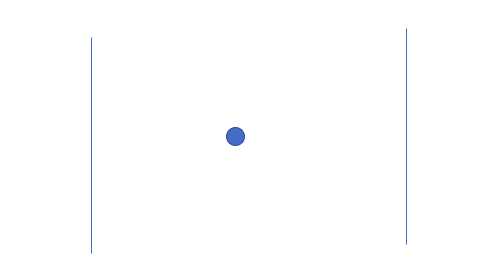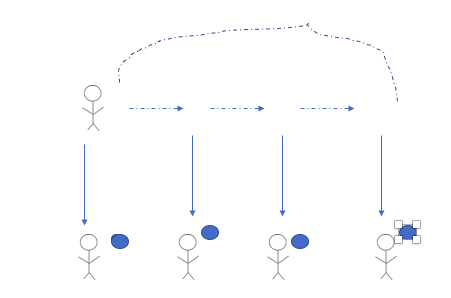Korfball exercises for u8
Ball skills
- Each child gets a ball
- The children imitate the exercises given by the trainers
- You spin the ball around your belly
- You bend your knees and make an 8-move through your legs with the ball
- You stand up straight and throw the ball from one hand over your head to the other hand (width or length)
- You lift your knees and in the meantime you make 8-movements through your legs with the ball
- You repeat these exercises a number of times
A nice variation of the ordinary game of tag.
You have a cat (the ticker) and you have mice. The mice have ribbons in their back trousers. This is like the tail of the mouse.
Make sure that the tail is hanging out quite a bit, otherwise the cat can't catch them.
The mice run away and the cat will try to grab all the tails. When the tail is taken away from the mouse the game is over and she can sit on the side of the road.
Variant: If the mouse's tail is picked up, the mouse can help the cat and becomes a cat.
If you have a large team you can start with 2 cats.

Divide into 2 teams.
In each team the children get numbers (silently give them to each team). Once everyone has a number, the ball is placed in the middle between the teams.
Then we call out a number (can also be several numbers) and they try to be the first to take the ball back to their "camp".
Once a child has taken the ball in the middle, the other child may try to tap him.

4 children stand next to each other, about 5 meters apart.
1 child goes to work:
Receives the ball at the first cone, returns it to the player across, and runs on to the second cone and so on.
At the back cone he returns 100% sprint.
Variation:
First all passes with left, then right, then 2 hands, then throw high in the air and throw back in the air.
The same as with the through ball, but with a dodge.
First all shots on the left and then on the right.
In short: various games of tag.
Overlap. The players stand on one long side of a rectangular area (about the size of a gymnasium). The rat runs somewhere in the middle of the area. When the trainer tells them to, all players must run over to the other long side. The scapegoat tries to catch as many players as possible. When they get through the area, they have to wait for the next signal to go back. Who is not tagged in 6 times? This game of tag can also serve as a playful exercise in defending.
Free running
Goal:
To learn to make a free run so that the player is ready to play the ball.
Points of attention
The moment of free running is important, it has to happen at the moment the ball can be thrown. The feint enters the picture. The feint suggests that you are going to do something to which the opponent is going to react, after which the final movement is carried out For example, a body movement is made to the left, the defender moves to the left but the attacker does not complete the movement and moves to the right The result is that the attacker is free.
Organisation:
The game is played in teams of four with a basket and a ball. Two people stand about 6 to 8 metres from each other, an attacker and a defender walk between them. The attacker must try to play together with the people on the fixed position. The basket is placed just outside the line of the regular players. The aim is that the attacker passes on the ball as much as possible to the regular players within a certain time. The defender must try to intercept the ball.
Variation:
1. The attacker may score on the basket after passing the ball several times2
. If he also scores, he gets an extra point. If the defender intercepts the ball, there is a change of position.
Continuation:
1. There are two baskets with a supporting player underneath with the ball. Between the baskets are an attacker and a defender. The attacker may score on both baskets.
2. A supporting player stands about 6 to 8 meters in front of the basket. An attacker and a defender stand between the basket and the supporting player. The defender is only trying to intercept. The attacker tries to get free so that he can play the ball. If he succeeds in doing so, he can score freely at the basket. So it is important to get free close to the basket.
Tip for the coach:
1. Always try to make a rotation schedule so that the winning or scoring players are rewarded. But also the weaker brothers must be able to practice.
2. Keep it attractive by offering different forms that give a chance to score or win, there must be an element of competition in it. Then it remains exciting.
3. Try to put players of the same level together. Fair competition.
4. It is also important that children experience success, which means that they feel that they can do something (well). If everything always fails, it's no fun.
Use of space
Goal
Make the players aware of the space within the field of play and how to use it.
Points of attention
Choosing a useful position so that the player can play and/or score.
Organisation:
Within the playing field there are two circles (often there are already lines in the hall, e.g. for basketball), the circles are playable all around (just like the basket). A goal can be scored when a player bounces the ball in the circle and a teammate catches the ball. Further rules are the same as for korfball.
Variation:
1. It is also possible to play with one circle. After this, the party may attack.
2. After a score, the ball may be played on by the party that has possession of the ball.
Continuation:
1. Both parties may score at both circles, this allows you to move the attack to the other circle. This offers many new tactical possibilities, also in terms of use of space and insight.
2. It is also possible to play with for example 4 circles. When playing with multiple circles, the circles can also be smaller, such as a hoop or a bicycle tire. The overview that the players have becomes more and more important.
Tip for the coach:
1. Pay attention to the timing of throwing and free running.
2. The space for free running is also determined by the defenders (the opponents).
3. Try to make a connection between the forms of practice and games, e.g. throwing two-handed was taught, the final game is hunter ball where you have to throw with two hands.
4. Make sure you build up the training material from easy to more difficult.
Rules of the game:
The defender may try to block the ball by provoking the attacker to throw against his hand. The defender's arm may not move in the direction of the attacker, but only in the path of the ball. The ball does not have to be released by the attacker during blocking.
You stand on 1 meter and shoot. When you have scored, you may stand at 2 meters. If you score there, you stand on 3 meter and so on and so on.
You can choose the distance yourself and also how much.
You can also choose to go for example to the 5 meter and then back to the 1 meter. You can do this individually or in teams:
Scoring is rewarded, so if you score, you can shoot again from one meter away. If you don't score then the next player can stand on your spot and you continue as a team.
Divide over the baskets (max 3 per basket). Each group gets a ball. Each player must stand within one meter of the post. The goal is to score 15 goals as a group. The ball is not allowed to fall on the ground, then the counter starts at 0 again.
- 5 shots on the wide line
- 10 through balls
- 10 pull-aways
- the chaos game is fun for younger children, but can also be played with older children.
- At the Chaos game the goal is that each child has a ball, and that there are 3 or 4 poles (also depending on the number of players)
- in a row.
- Each player starts at the same pole,
- There is a countdown and then they all start shooting,
- If they score, they may move one pole,
- If they don't score, they remain at the post until they have scored.
- You can decide beforehand whether they should pass each pole 1, 2 or 3 times, depending on the level.
- Variation: you can use cones to mark a circle outside which the players have to shoot,
- They are only allowed to enter the circle to catch the ball.
- The materials below are for 4 people (hat = pawn)








